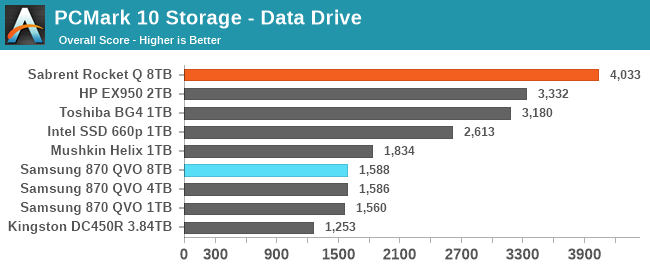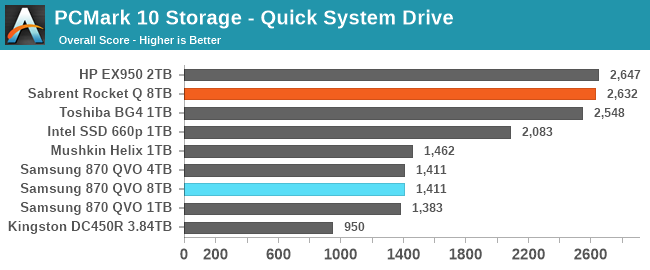QLC Goes To 8TB: Samsung 870 QVO and Sabrent Rocket Q 8TB SSDs Reviewed
by Billy Tallis on December 4, 2020 8:00 AM ESTPCMark 10 Storage Benchmarks
At the end of 2019, UL released a major update to their popular PCMark 10 benchmark suite, adding storage performance tests that had been conspicuously absent for over two years. These new storage benchmarks are similar to our AnandTech Storage Bench (ATSB) tests in that they are composed of traces of real-world IO patterns that are replayed onto the drive under test. We're incorporating these into our new SSD test suite, and including our first batch of results here.
PCMark 10 provides four different storage benchmarks. The Full System Drive, Quick System Drive and Data Drive benchmarks cover similar territory to our ATSB Heavy and Light tests, and all three together take about as long to run as the ATSB Heavy and Light tests combined. The Drive Performance Consistency Test is clearly meant to one-up The Destroyer and also measure the worst-case performance of a drive that is completely full. Due to time constraints, we are not yet attempting to add the Drive Performance Consistency Test to our usual test suite.
| PCMark 10 Storage Tests | ||
| Test Name | Data Written | |
| Data Drive | 15 GB | |
| Quick System Drive | 23 GB | |
| Full System Drive | 204 GB | |
| Drive Performance Consistency | 23 TB + 3x drive capacity | |
The primary subscores for the PCMark 10 Storage benchmarks are average bandwidth and average latency for read and write IOs. These are combined into an overall score by computing the geometric mean of the bandwidth score and the reciprocal of the latency score. PCMark 10 also records more detailed statistics, but we'll dig into those in a later review. These PCMark 10 Storage test runs were conducted on our Coffee Lake testbed:
| AnandTech Coffee Lake SSD Testbed | |
| CPU | Intel Core i7-8700K |
| Motherboard | Gigabyte Aorus H370 Gaming 3 WiFi |
| Chipset | Intel H370 |
| Memory | 2x 8GB Kingston DDR4-2666 |
| Case | In Win C583 |
| Power Supply | Cooler Master G550M |
| OS | Windows 10 64-bit, version 2004 |
Data Drive Benchmark
The Data Drive Benchmark is intended to represent usage a secondary or portable drive may be subject to. This test simulates copying around files, but does not simulate the IO associated with launching and running applications from a drive.
 |
|||||||||
| Overall Score | Average Bandwidth | Average Latency | |||||||
Starting off, the 8TB Sabrent Rocket Q leads the field thanks to its massive and fast SLC cache; it clearly outperforms even the decently high-end 2TB TLC-based HP EX920. The several capacities of the Samsung 870 QVO all performa about the same: less than half the speed of the faster NVMe drives, and slower than the slowest entry-level NVMe drives. The enterprise SATA drive with no SLC caching comes in last place.
Quick System Drive Benchmark
The Quick System Drive Benchmark is a subset of the Full System Drive Benchmark, running only 6 out of the 23 sub-tests from the Full test.
 |
|||||||||
| Overall Score | Average Bandwidth | Average Latency | |||||||
Moving on to the Quick test, the Sabrent Rocket Q no longer stands out ahead of the other NVMe drives, but still offers decent performance. The performance gap between the NVMe drives and the Samsung 870 QVO drives has narrowed slightly, but is still almost a factor of two.
Full System Drive Benchmark
The Full System Drive Benchmark covers a broad range of everyday tasks: booting Windows and starting applications and games, using Office and Adobe applications, and file management. The "Full" in the name does not mean that each drive is filled or that the entire capacity of the drive is tested. Rather, it only indicates that all of the PCMark 10 Storage sub-tests are included in this test.
 |
|||||||||
| Overall Score | Average Bandwidth | Average Latency | |||||||
The Full test starts to bring the downsides of QLC NAND into focus. The Sabrent Rocket Q is now the slowest of the NVMe drives, only moderately faster than the 8TB Samsung 870 QVO. The 1TB 870 QVO is also falling behind the larger and faster models. However, the QLC-based Intel 660p manages to hold on to decent performance, possibly a result of the class-leading SLC cache performance we usually see from Silicon Motion NVMe controllers paired with Intel/Micron flash.










150 Comments
View All Comments
Scour - Monday, December 7, 2020 - link
After experiences which some QLC-SSDs from Samsung and Crucial I have to say: Stay away from QLC if you want performance.Maybe it´s OK for ppl who install a windows and store some music or photos on it, but if you want to write larger amount of data you will be faster with HDDs.
It´s a shame that some ppl recommend a QVO because it have a Samsung-controller and DRAM. Don´t agree with them because some cheap TLC-SSDs are much faster.
Oxford Guy - Monday, December 7, 2020 - link
Samsung is often overrated anyway. Their planar TLC drives were so poorly made that they have to periodically rewrite the data that's on the drive to maintain decent performance.I also remember the company's completely bogus power consumption claims, claims that were taken as truth by consumers who would recommend the drives based on the deception.
Scour - Tuesday, December 8, 2020 - link
My 840 (first version) never was good, it was slower than some of my cheapest SSDs in daily use. I use it now for video-recording on a set-top-box. It´s fast enough for the writing-speed and it gets erased all 2-3 weeks.But the 850 and 860 Evo works good and fast.
The QVO-series maybe beats other QLC-products like DRAM-less BX500 (so far never seen benchmarks of new Sandisk Plus with QLC) but is to expensive in capacities less than 8TB
WaltC - Monday, December 7, 2020 - link
This has to be the first NMEe .M2-interface vs. SATA3-interface SSD comparison that ignores the differences in bus connections as if they don't exist--or as if they don't matter. Scratching my head over this one. Max optimal bandwidth for Sata3 SSD's is generally less than 550MB/s. Max optimal bandwidth for an .M2 NVMe 3x4 PCIe 3 drive like the Sabrent here is 3.5-5.x GB/s. And for PCIe 4 3x4 NVMe drives like the 980 Pro from Samsung, the max optimal bandwidth is as much a 7+ GB/s. Comparing the internal drive controllers and the onboard ram between SSD's is fine and should be done--but *never* at the expense of treating the drive interfaces into the system as if they just don't matter, imo...;) If people are merely looking capacities and prices without regard to performance this might be a helpful review. But when is that ever really the case? With SATA3 SSDs, it doesn't really matter about the internals, the performance is caped at < 550MB/s. The bottleneck being the drive's system interface.peevee - Wednesday, December 9, 2020 - link
2TB of SLC is equal to 8TB of QLC. I doubt the SLC flash is separate from QLC, they probably use QLC in SLC mode until 2TB fill up, and then start compressing the data into QLC. So the switch might happen without constant sequential write too.ballsystemlord - Wednesday, December 9, 2020 - link
@Billy , Under "Random Write Performance" (burst and sustained,) you'll notice that you wrote the same comment twice by mistake.zhpenn - Monday, February 8, 2021 - link
About the 8TB version power consumption, I notice in the spec is 5.5W when compare to 860 EVO(4W) Can I put 870 QVO 8TB into a USB 3.0 SATA enclosure and used it without an unstable issue? or it may eject unexpectedly or slow speed due to high power consumption?PushT - Thursday, October 14, 2021 - link
How big is the cache on this drive ? The 32 GB "sustained"transfer falls within that cache, is that right ? Say I wanted to make a backup of my whole system, on this drive, or just move the backup to it, or other large files for that matter. How would the sustained 128KB write performance look ? Why do you test for this rather small transfer size when it only showcases the faster cache ? Am I wrong ? Please tell me why you can't just as well include longer and larger transfers, so as to show what happens when the QLC nand is written to ?PushT - Thursday, October 14, 2021 - link
To be fair this drive has a large dynamic cache. You can transfer a lot of data before you hit the QLC nand directly. But if you look at the review at Tom's you can see how the perfomance actually drops to 200 MB/s after the cache is filled up, about that of a WD black HDD. That is not too impressive. Also I wonder about the heat when you start using these small drives for bulk storage...PushT - Thursday, October 14, 2021 - link
With the Samsung 870 Evo, as an example, you can fill up the whole drive with sequential writes at 500 MB/s. Looking at a potential bulk storage solution, you would write a full hypothetical 8TB Samsung Evo 870 sata ssd in approximately 4,43 hours, whereas filling a Sabrent rocket 8TB would take about 6,2 hours. So depending on your usage, there are trade-offs. If I was to copy drives I don't see why I would use this over a top Sata ssd.